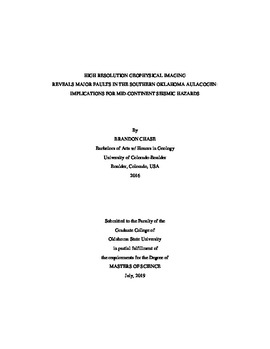| dc.description.abstract | While intraplate seismicity can occur anywhere, events frequently localize along preexisting buried basement faults associated with ancient tectonic features and boundaries (ATFBs). Detailed structural study of these structures can help to determine critically oriented faults vital for intraplate seismic source models and hazard assessments. Here, we use recently acquired high resolution aeromagnetic data over the Southern Oklahoma Aulacogen (SOA), a failed Cambrian rift which experienced inversion during the Ancestral Rocky Mountain orogeny, to provide an unprecedented view of the basement. We integrate the aeromagnetic data with seismic reflection, well-log, remote sensing, field, and earthquake data to assess the modern seismic hazard of SOA faults. Our results reveal the dominance of NW and E-W trending fault sets, the latter of which contains a previously unmapped ~100 km-long E-W trending sinistral strike-slip fault, which we call the Willow Fault. Our results also augment the subsurface extent of the NW trending Meers Fault, the only known seismogenic fault with Quaternary expression in south-central United States. Further, we demonstrate the seismic hazard of the major faults in the SOA; and show that in the current stress field the NW trending Meers Fault is critically oriented, while the additional NW trending faults could represent additional hazards. We also find that the Willow Fault, and the other sub-vertical E-W faults, while not critically oriented in the regional stress field, are not mis-oriented for failure. Recent observations of pronounced natural seismicity along E-W and NW-striking planes in the SOA and the flanking Texas Panhandle underscore the contemporary seismic hazards of the buried structures. The investigative approach and results presented in this study demonstrate both the seismic hazard of intraplate ATFBs and the method of characterizing the relevant buried faults. | |
